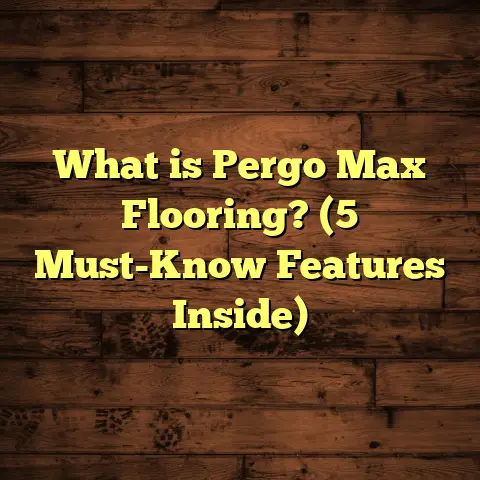What is Flooring? (5 Types That Transform Your Space)
Have you ever walked into a room and felt that something was just a bit off? Maybe it was the dullness of the flooring that made the space feel lifeless. I’ve found myself in this very situation on multiple occasions. Flooring plays a crucial role in the overall aesthetic and functionality of your home. However, choosing the right type of flooring can feel like an overwhelming task, especially with so many options available. So, what do you do when faced with this challenge? Let’s explore some of the most popular flooring options that can truly transform your space.
The Journey of Flooring Materials
Hardwood: The Timeless Classic
Let’s start with hardwood—an option that has stood the test of time. I remember the day I decided to install hardwood floors in my living room. The process was not just about choosing a material; it was about creating an atmosphere that felt warm and inviting. The rich hues of oak planks added a touch of elegance that laminate or vinyl simply couldn’t replicate.
Hardwood flooring is typically crafted from solid wood, with popular species including oak, maple, cherry, and walnut. The manufacturing process involves cutting logs into planks and drying them to a specific moisture content. This step is critical as it affects the wood’s stability and durability. If you’ve ever experienced squeaky floors or gaps between planks, it could be due to improper drying.
Here’s a little insight: hardwood can last for generations when properly cared for. In fact, I know a family whose hardwood floors are over a century old! They’ve experienced a few refinishes over the years, but those floors still shine like new. According to industry statistics, about 80% of homeowners who install hardwood flooring report feeling more satisfied with their homes.
One thing I’ve learned is that maintenance is key to preserving hardwood floors. Regular sweeping and occasional mopping with a wood-safe cleaner can keep them looking pristine. Additionally, refinishing them every 5-10 years can help restore their original beauty and protect against wear.
Laminate Flooring: The Unsung Hero
When I first heard about laminate flooring, I was skeptical. Could it really provide the same aesthetic appeal as hardwood while being more affordable? After installing laminate in my guest bedroom, I quickly changed my tune. The ease of installation and stunning appearance made me a fan.
Laminate is made by fusing several layers together: a high-density fiberboard (HDF) core, a design layer that mimics wood or stone, and a protective wear layer on top. The manufacturing process combines these layers under high pressure to create a sturdy product that can withstand daily wear and tear.
One of the standout features of laminate is its resistance to scratches and stains. With pets and kids running around, this became a game-changer for me. Studies show that laminate flooring can withstand heavy foot traffic better than many traditional options. It’s also worth noting that laminate is less expensive than hardwood—making it an attractive option for budget-conscious homeowners.
When I installed laminate in my home, I appreciated how straightforward the process was. Thanks to its click-lock system, I didn’t need to hire a contractor. I laid the flooring myself over a weekend, which not only saved money but provided a great sense of accomplishment.
Tile Flooring: Versatility at Its Best
Have you ever walked on beautifully laid tile floors? There’s just something about them that feels luxurious. When I renovated my bathroom, I chose ceramic tiles for their water resistance and durability. The transformation was remarkable; the room felt brighter and more spacious.
Tile flooring is made from clay that is shaped into tiles and fired at high temperatures—a process that gives them their strength and durability. One of the most appealing aspects of tile is its versatility; you can find designs ranging from classic subway tiles to intricate mosaics that can elevate any space.
In my bathroom renovation, I opted for large-format tiles to minimize grout lines and create a seamless look. According to industry data, larger tiles have become increasingly popular due to their modern aesthetic and ease of cleaning. Tile is inherently resistant to moisture, making it an excellent choice for kitchens and bathrooms where spills are common.
Another fascinating aspect of tile flooring is its energy efficiency. In colder climates, tiles can retain heat from sunlight, helping to naturally warm your home during the day. When I visited a friend’s house with radiant heating beneath their tile floors, I was amazed at how comfortable it felt—even on chilly days!
Concrete Flooring: The Modern Marvel
Concrete used to be something I associated only with garages or basements. However, after visiting a friend’s loft with polished concrete floors, I quickly realized how elegant they could be. The smooth finish gave the space an industrial yet chic vibe that was hard to resist.
Concrete flooring is created by pouring a mixture of cement, sand, gravel, and water into molds or directly onto surfaces. One of the biggest advantages of concrete flooring is its sustainability; many products are made from recycled materials. Plus, concrete can be stained, polished, or stamped to achieve various looks—making it incredibly versatile for different styles.
During my visit to that loft, I learned about how polished concrete can reflect light—helping reduce energy costs by minimizing the need for artificial lighting. Research shows that polished concrete not only looks great but is also highly durable, making it suitable for high-traffic areas.
I also discovered that concrete floors can be easily maintained with regular sweeping and occasional mopping. For those considering this option, it’s essential to seal the concrete regularly to protect against stains and moisture infiltration.
Vinyl Flooring: Affordable Luxury
Finally, let’s dive into vinyl flooring—a game-changer in the world of home design! When I first heard about luxury vinyl planks (LVP), I was curious yet skeptical. Could they really match the elegance of hardwood while being budget-friendly? After installing LVP in my kitchen, I became an advocate for this versatile material.
Vinyl flooring is made from several layers: a backing layer for stability, a core layer for durability, a design layer for aesthetics, and a wear layer for protection against scratches and stains. The manufacturing process has evolved significantly; modern vinyl can replicate the look of natural wood or stone so closely that it’s hard to tell the difference at first glance.
What surprised me most was how comfortable LVP feels underfoot compared to traditional hardwood or tile. It’s also waterproof! This makes it an excellent choice for areas prone to moisture like kitchens and bathrooms. A survey revealed that over 60% of homeowners opting for vinyl did so primarily for its water-resistant properties.
The installation process was straightforward as well; LVP often comes with a click-lock installation system that makes it easy for DIY enthusiasts like me to lay down without professional help.
Factors to Consider When Choosing Flooring
When deciding on flooring material, several critical factors come into play:
- Foot Traffic: Consider how much foot traffic your space receives daily. High-traffic areas may benefit from durable options like laminate or tile.
- Moisture Levels: For bathrooms and kitchens, moisture-resistant materials like tile or vinyl are ideal.
- Budget: Determine how much you’re willing to spend upfront versus long-term maintenance costs.
- Aesthetic Preferences: Think about the overall design style you want to achieve in your home.
- Sustainability: Many homeowners are increasingly prioritizing eco-friendly materials—consider options made from recycled or sustainably sourced materials.
I remember when I was choosing flooring for my home office; I weighed all these factors before settling on bamboo flooring—a sustainable choice that offered both style and durability.
Maintenance Tips for Different Flooring Types
Once you’ve chosen your flooring type, understanding how to care for it is crucial for longevity:
- Hardwood: Regularly sweep or vacuum to remove dirt and debris. Use a damp mop with wood-safe cleaner occasionally; avoid excessive water which can warp the wood.
- Laminate: Sweep or vacuum regularly; avoid wet mopping as excess moisture can seep between seams.
- Tile: Sweep or vacuum regularly and mop with a tile-safe cleaner for stubborn stains.
- Concrete: Regularly sweep and mop with warm water; seal every few years to protect against stains.
- Vinyl: Sweep regularly and damp mop with a mild detergent; avoid harsh chemicals that could damage the finish.
Flooring Trends: What’s Hot Right Now?
Every year brings new trends in home design and flooring is no exception. Here are a few trends I’ve noticed recently:
- Natural Finishes: Homeowners are gravitating toward natural wood finishes rather than glossy ones; it creates a more organic feel.
- Large Format Tiles: These have gained popularity due to their ability to create seamless looks in spaces.
- Eco-Friendly Materials: Sustainable options like bamboo and reclaimed wood are becoming increasingly sought after.
- Textured Surfaces: Textured finishes add depth and interest to spaces; think distressed hardwood or textured tiles.
- Bold Patterns: Whether in tile or area rugs, bold patterns can make striking focal points in any room.
Personal Anecdotes: My Flooring Journey
Reflecting on my experiences with different types of flooring has been quite enlightening. Each choice has taught me something valuable:
- When I installed hardwood floors in my living room, it was not just about aesthetics—it transformed how I felt about my space. Hosting friends became more enjoyable as they complimented the warmth of the wood.
- My venture into laminate flooring taught me about resilience; even with pets running around, my floors remained scratch-free!
- Renovating my bathroom opened my eyes to tile versatility—how different patterns can dramatically change the room’s ambiance.
- Opting for polished concrete in my basement has been one of my best decisions; it’s stylish yet incredibly easy to maintain.
- Installing luxury vinyl planks in my kitchen combined practicality with style—I never knew vinyl could look so good!
Conclusion
Flooring is more than just covering for your floors; it’s an essential element that shapes our living spaces. Each type has its unique charm and benefits, making it vital to find what resonates with you personally.
As I reflect on my journey through various flooring materials, I realize how much they influence our daily lives—how they provide comfort underfoot and set the tone for our homes.
So next time you’re standing in a room, take a moment to appreciate the floor beneath you—it might just inspire your next home improvement project! What kind of flooring have you been considering? Let’s chat about it!





